Housing market conditions favour buyers
Weak sales activity relative to inventory places downward pressure on prices
Persistently high inventory levels within Calgary’s residential resale housing market, combined with weak sales activity, contributed to buyers’ conditions in November.
Monthly sales totaled 1,263 units, a 28 per cent decline from last year and nearly 20 per cent below the 10-year average. Meanwhile, the amount of new listings in the market increased by five per cent over last November, and moved five per cent above 10-year average.
The combination of both soft sales and elevated listings caused months of supply to rise above four months. It represents the third consecutive month that housing supply in the city has remained near four months, which is an indicator that supports buyers’ conditions.
“The housing market is reflecting the realities of the economic conditions,” said CREB® chief economist Ann-Marie Lurie. “Calgary has continued to post job losses in the energy sector, unemployment levels are high, wages are down and recovery expectations have changed. All of these factors have contributed to the weak demand we have seen throughout the year.”
CREB® president Corinne Lyall pointed out that inventory levels still remained 27 per cent below the November highs recorded in 2008.
“Furthermore, price declines have not been as steep as those recorded during the last downturn,” she said.
The unadjusted benchmark price in November declined to $450,700, a 0.5 per cent drop compared to last month and two per cent from last year.
Calgary’s detached housing sector faired the best in November as months of supply increased to only 3.4. Nonetheless, the unadjusted benchmark price declined by 0.6 per cent compared to October, and 1.52 per cent from November 2014, to $510,700.
In the attached category, buyers’ conditions emerged as months of supply increased to 4.8. As a result, the unadjusted benchmark price declined to $352,400, a 0.5 per cent drop from last month and 1.5 per cent from last year.
The apartment sector continued to be the hardest hit of the three sectors. Months of supply increased to 6.9 in November, causing benchmark prices to slide 0.5 per cent from October to $287,000. Meanwhile, year-over-year prices were off by 4.6 per cent.
Despite weaker absorption rates for most of 2015, residential benchmark prices have only recently started to decline – while average and median prices have dropped more dramatically. Lurie attributed that to slower activity in the higher-priced segments of the market, which can skew average and median prices.
Benchmark prices represent changes for similar-type homes, minimizing the impact caused by changes in distribution.
“It is not a surprise that the average price has recorded a steeper decline than the benchmark price,” she said. “Last November, detached sales in the city over $700,000 totaled 159 units or 15 per cent of the market sales. This November, there were only 103 sales representing 13 per cent of the market sales.”
Lyall said knowing the difference between indicators such as average, median and benchmark prices is important for sellers.
“There is no question that this can be a challenging market,” she said. “However, because of these circumstances there is a greater need for market intelligence.”
Click Here, on the following link or on the image below for the full .pdf of the November_2015_Monthly_Housing_Statistics

statistics report
Calgary luxury home sales on record pace
Every month this year has set a new peak for MLS transactions
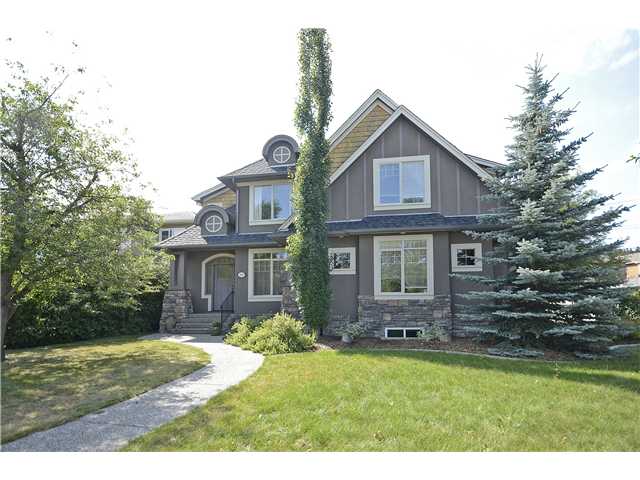 The appetite for luxury homes in Calgary continues to be very strong as another MLS sales record was established in August.
The appetite for luxury homes in Calgary continues to be very strong as another MLS sales record was established in August.
According to the Calgary Real Estate Board, there were 69 properties that sold for $1-million or more during the month, eclipsing the previous monthly high of 64 set last year.
Each month this year has established a record for luxury home sales.
Year-to-date, there have been 611 luxury home sales until the end of August compared with 522 for the same period last year. The all-time peak for annual sales at the $1-million plus level was in 2013 with 726 MLS transactions.
“Bolstered by the city’s thriving economy, the strength of its oil and gas sectors, low unemployment rates, high average net incomes and strong net migration, the market for high-end homes continued its upward trajectory with single-family home sales up 19 per cent and attached home sales up 21 per cent year-over-year,” said Sotheby’s International Realty Canada’s Top-Tier Real Estate Report for the first half of the year, which was released on Thursday.
“Due to limited inventory in Calgary’s condo market, sales decreased 25 per cent compared to the same time last year. With a number of new high-end condo projects recently announced in Calgary’s downtown core, it is expected that the volume of luxury condo sales above $1 million will increase in the second half of 2014.”
Ross McCredie, president and chief executive of Sotheby’s International Realty Canada, said the Calgary housing market is still relatively inexpensive for many people who have moved to the city from other parts of Canada.
“There’s a ton of different factors (to the luxury home boom) but overall there’s a ton of confidence,” he said.
“Low interest rates, a lot of confidence specifically in Calgary where you have a lot of investment, very, very low unemployment and you have huge demand for jobs . . . Overall we don’t see anything that’s going to change in the horizon right now for us.”
The Sotheby’s report said low inventory in the beginning of the year drove bidding wars and price increases in a market that favoured sellers.
“Over the summer months, new inventory over $1 million emerged to meet strong consumer demand, particularly in the condominium market, a trend which is expected to continue into the fall,” it said. “At the same time, Calgary’s robust economy is expected to sustain demand for luxury real estate, and notable growth is expected in the $4 million single-family home market throughout the fall and into 2015 as this category has already outpaced 2013 sales numbers.”
By Mario Toneguzzi, Calgary Herald
CALGARY REGIONAL HOUSING MARKET STATISTICS – August 2014
Condominium sales set a new record for August activity
Sales activity improves for condominium product, while declining in the single-family sector
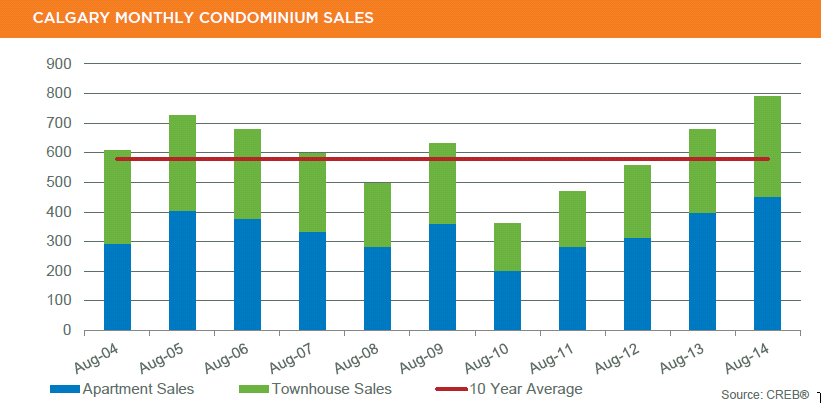
Strong gains in Calgary’s condominium apartment and townhouse sectors sparked a 3.4 per cent year-over-year growth in residential resale housing sales activity for August. A total of 2,267 units exchanged hands in the city during the month, compared to 2,192 during the same period in 2013.
The condominium apartment and townhouse sectors saw the biggest gains, increasing by nearly 14 and 20 per cent, respectively, for total monthly sales of 790 units. “The record pace of August sales in the condominium sector is related to the relative affordability of this product combined with a tight rental market and low lending rates,” said CREB® chief economist Ann-Marie Lurie, noting most of the activity continues to take place in lower price ranges.
“More than 76 per cent of condominium new listings are priced below $400,000 and represent more than 68 per cent of the total inventory within city limits.” So far this year, condominium apartment and townhouse sales have totaled a respective 3,388 and 2,685 units. This represents a combined increase of nearly 20 per cent.
“Over the past three months apartment-style new listings have increased by more than 40 per cent year over year, pushing up overall inventory levels and moving this market toward balanced territory despite the strong sales growth,” said Lurie. Meanwhile, year-over-year single-family sales declined by 2.4 per cent in August to 1,477 units, partly due to limited availability in lower price ranges. Despite the pullback, activity in the sector remains stronger than long-term averages.
“The decline in single-family sales is mostly due to the shrinking supply in the under-$400,000 sector,” said CREB® president Bill Kirk. “Overall, sales activity has improved compared to last year for product priced over $400,000.”
The good news for buyers is added choice. New listings in August improved by 13.6 per cent compared to last year, causing inventories to rise by nearly 18 per cent. Increased inventory levels also moved the single-family market toward more balanced conditions, helping minimize further monthly price gains.
The single-family unadjusted benchmark price totaled $512,300 in August, similar to July, but still 10.24 per cent above $464,700 posted a year ago. “Following a prolonged period of Calgary being a sellers’ market, a move toward more balanced conditions is welcome news,” said Kirk.
“This will help support a more stable city housing market in terms of price gains.” The average, median and benchmark prices for condominium apartments in August were a respective $332,006, $287,500, and $298,200. “While both average and median prices in this sector have recorded further monthly gains, the benchmark indicates prices are similar to levels recorded in the previous month,” said Lurie.
“The composition of apartment sales shifted toward the higher-end segment this month compared to last month, resulting in higher monthly gains. The benchmark price reflects price changes for similar properties, less subject to the variability in composition.”
Condominium townhouses remain the tightest of the three sectors in Calgary, resulting in further monthly price gains and reaching an August benchmark price of $328,300. While prices are shy of previous highs, they increased by 0.4 per cent over the previous month and nearly 10 per cent above levels recorded in August 2013.
Click Here to view the full .pdf of the CALGARY REGIONAL HOUSING MARKET STATISTICS – August 2014
Calgary resale housing market experiences highest annual price growth
10.48% hike from a year ago
Calgary continues to far outstrip the rest of the country when it comes to annual price gains in the resale housing market.
The MLS Home Price Index, released Friday by the Canadian Real Estate Association, said prices in the Calgary area in July were up by a whopping 10.48 per cent compared with a year ago. Meanwhile, the national aggregate, comprising 11 centres, saw a year-over-year hike of 5.33 per cent as sales rose to their highest level since March 2010.
The closest centre to Calgary’s annual spike was Toronto which recorded a jump of 7.88 per cent.
“As market conditions move toward more balanced conditions, it is causing prices to level off. However, due to strong gains in the first half of the year, even with prices levelling off, year-over-year gains remain at higher levels,” said Ann-Marie Lurie, the Calgary Real Estate Board’s chief economist.
Over the past three years, Calgary also has the highest rate of price growth at 25.01 per cent compared with 12.52 per cent nationally. And over five years, Calgary’s 28.89 per cent spike is second only to Toronto’s 40.48 per cent increase while it is 26.89 per cent across the country.
Don Campbell, senior analyst with the Real Estate Investment Network, said it takes 18 months for immigration and population growth to begin to affect the resale and new housing markets. Also, a demand/supply imbalance has contributed to higher prices.
He said the housing market is being affected by tightness in rental vacancy and lack of new supply.
“So the record population growth we witnessed last year is now being felt,” he said.
“Combine this with a general decrease in available single-family home building lots and this is keeping the inventory tighter than normal, thus adding upward value pressure on resale market.”
The number of homes sold nationally through the MLS systems of Canadian real estate boards and associations rose to 48,000 in July – a 7.2 per cent hike from a year ago.
Calgary area sales of 3,177 were 6.8 per cent higher and Alberta sales of 7,194 were up 5.0 per cent.
“Low mortgage interest rates continue to bolster home sales activity,” said Gregory Klump, CREA’s chief economist, in a news release. “With the Bank of Canada widely expected to hold interest rates steady until next year, home purchase financing will remain attractive over the second half 2014 and continue to support economic growth while waiting for Canadian exports and investment to improve.”
In terms of average MLS sale prices, Calgary saw a rise of 5.2 per cent year-over-year to $460,790 while the increase was 4.2 per cent in Alberta to $395,552 and 5.0 per cent across the country to $401,585.
Leslie Preston, economist with TD Economics, said low interest rates are continuing to fuel the Canadian housing market into the summer.
“The renewed momentum in Canada’s housing market in recent months represents both a bounce back from weather-related weakness over the winter months and a response to lower mortgage rates,” explained Preston. “Potential buyers who may have sat on the sidelines last year as interest rates rose, are being enticed back to the market by lower interest rates. Meanwhile, a strengthening in economic growth continues to support the fundamental demand in the housing market.
“However, existing home prices . . . are on track to outstrip income growth for a second straight year in 2014, which adds to concerns about an already-overpriced market. Affordability, even at low interest rates, has become an obstacle in many markets. This contributes to our view that the Canadian housing market will cool later this year and into 2015 as interest rates are likely to nudge higher. Another factor which is expected to weigh on prices is the supply growth in the pipeline due to the record number of new homes that are under construction in many markets.”
By Mario Toneguzzi, Calgary Herald
Calgary region housing starts to increase 24% in 2014
But decline almost 8% in 2015
Housing starts in the region are forecast to rise by 24 per cent in 2014 from last year but then dip by 7.7 per cent in 2015, according to a new report released Wednesday by Canada Mortgage and Housing Corp.
The agency’s housing outlook says starts in the Calgary census metropolitan area will increase from 12,584 in 2013 to 15,600 this year but then fall to 14,400 next year.
“The rise in total housing starts this year is due to a combination of increased demand and a decline in supply,” said Richard Cho, senior market analyst in Calgary for the CMHC. “Employment growth in Calgary continues to post impressive gains with the majority in full-time positions. Low mortgage rates have also helped people purchase a home and migration has been elevated in the last couple of years. This has supported the demand for housing. Selection in the resale market has been low which has led to some prospective buyers to look to the new home market. Not only are active listings low but new home inventories are down, which will also contribute to the rise in construction this year.
“In 2015 total housing starts are forecast to decline but still reach its second highest level since 2006. Job creation in Calgary is forecast to moderate from the elevated pace in 2014 and net migration, although remaining positive, will decline as economic conditions improve in other areas of the country. We are also anticipating that buyers will have more homes to choose from as average monthly active listings are expected to be higher. The number of new homes under construction has increased and may put more upward pressure on inventories when completed. This will impact the opportunity to increase new construction in 2015.”
For Alberta, starts are forecast to increase by 7.2 per cent this year to 38,600 units but decline by 4.7 per cent next year to 36,800 units.
The agency is expecting MLS sales in the Calgary region to improve by 9.8 per cent this year to 32,900 units and by another 2.4 per cent in 2015 to 33,700 transactions. CMHC says the average MLS sale price will rise by 5.0 per cent in 2014 to $459,000 and by 2.8 per cent in 2015 to $472,000.
“The economy in Calgary is anticipated to continue creating jobs, attracting migrants and supporting income growth,” said Cho. “However, the rate of increase in some of these key housing demand factors will moderate throughout the forecast period. This will also be reflected in the resale market.
“Home prices in Calgary have experienced more upward pressure from the low supply of active listings on the market compared to previous years. Buyers have been competing for a lower selection of homes, resulting in multiple offers on many homes and shortening the average days-on-market. The MLS price is forecast to rise five per cent in 2014. As we move towards the end of 2014 and into 2015, the supply of resale homes is anticipated to move higher. New listings in Calgary have started to pick up and are forecast to rise this year and next. This will help ease some of the upward pressure on prices in 2015 resulting in a 2.8 per cent increase.”
For Alberta, MLS sales are forecast to be 5.8 per cent higher this year to 69,900 followed by a 2.9 per cent gain next year to 71,900.
The average sale price in the province is expected to increase by 4.2 per cent this year to $396,800 and by 2.6 per cent next year to $407,000.
CALGARY REGIONAL HOUSING MARKET STATISTICS – July 2014
Growth in new listings outpace sales growth in July, supporting double-digit inventory gains
Calgary, Aug. 1, 2014 – Residential sales this month totaled 2,336 units, a record level for July activity. However, year-over-year sales growth slowed to 3.18 per cent.
“While July’s sales growth seems like a dramatic departure from the double-digit gains recorded in the first half of this year, it is in comparison to exceptionally strong sales during the same period last year,” said CREB® chief economist Ann-Marie Lurie, noting July sales this year are nearly 19 per cent above long-term averages for the month.
New listings in July totaled 3,219 units, an 18 per cent increase over the previous year. The rise outpaced sales growth during the month, pushing inventory to 4,659 units, nearly 14 per cent higher than July 2013 levels.
“More selection is welcome news for many potential purchasers. However, improving supply levels have only come after nearly three consecutive years of declines,” said CREB® president Bill Kirk. “Along with improving inventories, other indicators support the notion that market conditions are moving toward more sustainable levels.”
Single-family unadjusted benchmark prices totaled $511,600 in July, just above May figures, but 10.8 per cent higher than $461,600 in July 2013.
“Following two years of annual increases and several months of monthly gains that exceeded one per cent, unadjusted benchmark prices appear to be leveling off,” said Lurie. “This fits with our expectations as the market moves into more balanced territory.”
Single-family sales totaled 1,553 units in July, a 1.3 per cent decline compared to the same period in 2013 and a 8.3 per cent increase year-to-date.
While overall single-family sales remain higher than long-term trends for this month, the year-over-year monthly decline reflects fewer sales and listings in properties priced under $400,000.
“With declining choices in the lower-priced single-family market sector, consumers are considering both condominium apartment and townhouse segments,” said Kirk.
Year-to-date condominium apartment and townhouse sales increased by 21 and 19 per cent, respectively. New listing growth far outpaced sales growth, particularly in the apartment sector, thus boosting inventory levels.
For buyers, more choice has helped ease some of the upward pressure on benchmark prices. Unadjusted prices in both apartment and townhouse-style condominiums were similar to levels recorded the previous month. Despite slower monthly gains, year-over-year price growth grew by 11 per cent in the condominium sector. Benchmark prices for apartment and townhouse-style condominiums in July totaled $298,100 and $327,000, respectively.
“Calgary’s housing market continues to demonstrate exceptional levels of sales, and strong year-over-year price gains,” said Lurie. “This is a reflection of the economic factors supporting this market, including gains in net migration, employment, wage growth and favourable lending rates.”
Click on the image below or the following link for the full .pdf report: Calgary Regional Housing Statistics for July 2014
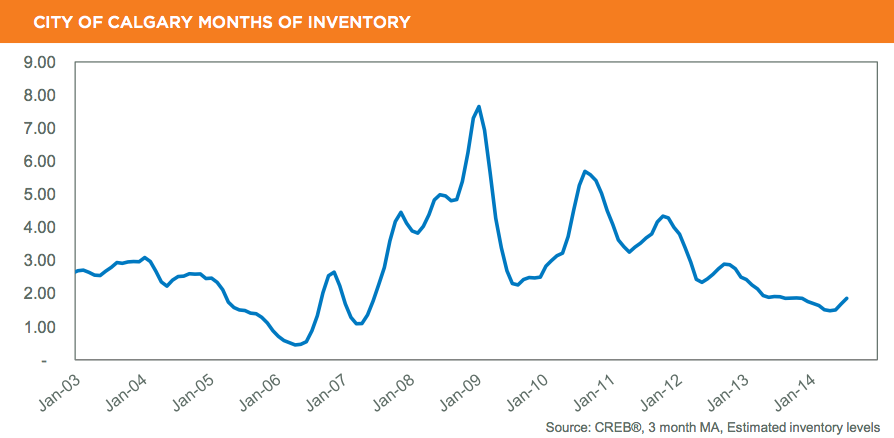
CALGARY REGIONAL HOUSING MARKET STATISTICS for June 2014
Housing supply improves in June
Condominium apartment benchmark price surpasses previous highs
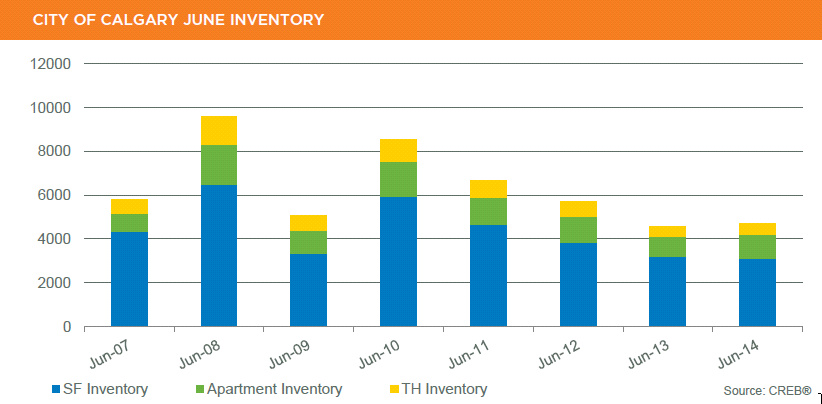 click on the link or image above for the full CALGARY REGIONAL HOUSING MARKET STATISTICS for June 2014
click on the link or image above for the full CALGARY REGIONAL HOUSING MARKET STATISTICS for June 2014
Residential sales and listings in Calgary increased by double-digit rates in June compared to the same time last year. This increase is partly due to the floods impacting housing activity throughout the second half of June 2013.
“Last June was not a normal month, so it’s difficult to compare the two,” said CREB® president Bill Kirk. “The historic floods of 2013 forced residents and business owners from their homes and places of work. It’s not surprising that many Calgarians were not focused on purchasing or listing their home at that time.”
Despite the unusual circumstances of last year, the housing market continues to demonstrate strong demand. Residential sales totaled 2,670 units this June, which was 18 per cent above the 10-year average. Total sales for the first half of 2014 increased to 13,929 from 12,257 in 2013.
New listings totaled 3,814 units in June, representing the first time since June 2010 that it outpaced the long-term average. The monthly influx of new listings also helped ease some of the tightness in the market by improving inventory levels, which totaled 4,726 units compared to 4,584 in June 2013.
“Economic conditions continue to support housing demand growth. However, improving supply should help push our market toward more balanced conditions,” said CREB® chief economist Ann-Marie Lurie. “Over time, this will cause price growth to ease from its current levels.”
Single-family unadjusted benchmark prices totaled $509,700 in June, a one per cent increase over the previous month, and a 10.9 per cent increase over June 2013.
Single-family sales for June totaled 1,769 units, which outpaced the 10-year average by 10 per cent. The rise in sales activity was largely due to improved new listings. While this helped ease some of the tightness in this market, supply levels continue to fall in this sector.
The boost in single-family new listings for June was largely due to an increase in units listed at more than $500,000 – rising to 1,359 units in June from 954 the year prior.
“With less resale single-family product available in the lower price ranges citywide, this market continues to be fairly competitive,” said Kirk. “However, for consumers looking in the higher price ranges, there is often more choice.”
Condominium apartment sales for the first half of 2014, totaled 2,494 units, compared with 2,027 during the same period a year prior. While new listings growth kept pace with sales activity during the first part of the year, it has exceeded sales growth over the past two months, pushing up inventory levels and moving this market into more balanced conditions.
Apartment-style benchmark prices totaled $299,700 in June, a new high in the condominium apartment sector and 13.5 per cent increase over the previous year. Meanwhile, the benchmark price for townhouse-style units reached $326,000, still shy of previous records.
“As citywide condominium apartment prices have finally recovered from 2007 highs, we would expect this will continue to encourage some listings growth,” said Lurie. “However, as this market has moved into more balanced conditions, and if inventories continue to rise, price growth should ease throughout the remainder of the year.”
Cottages, Camps, Cabins and Condos – RE/MAX report sees sunny skies ahead for recreational property sales in Canada
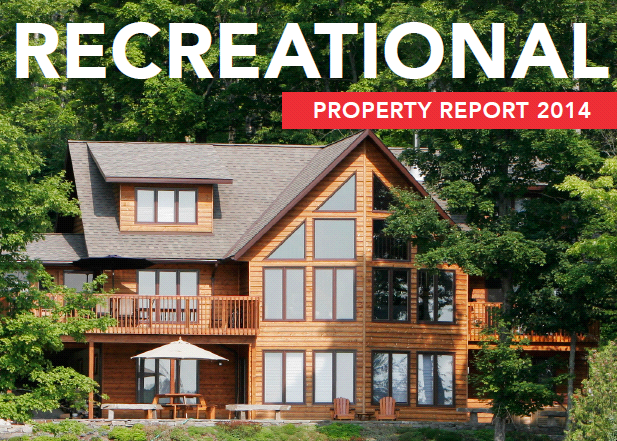
Today RE/MAX released its annual Recreational Property Report, showing healthy activity across much of the country and forecasts modest increases in sales and prices through the rest of the year. With schools out and the coming Canada Day long weekend marking the unofficial start of summer, national recreational property sales and listings have rebounded from a slow start caused by the late spring and cold winter experienced in many markets throughout the country.
National Trends: While there are nuances and specific attractions that define local markets across the country, a number of broad national trends have been observed.
Buyer Profiles: Two groups of buyers are driving the majority of recreational properties sales in Canada. The first is made up of families with younger children, who have built up equity in their primary residence and are using that money to purchase a vacation property. The second group is made up of near or recent retirees who have purchased a recreational property with a plan to use it as a primary summer residence and launching pad for winter travel.
Residential Spillover: Canada’s hot residential real estate market in urban centres has had a spillover effect on recreational property sales. This is particularly true in markets within a two-hour drive of the country’s large urban centres, where price appreciation has allowed homeowners to use equity gains in their primary residence to purchase a second home for recreational use.
Evolving Use: The way buyers are using their recreational properties is changing. While in the past, properties were largely used for weekend getaways and a week or two of summer vacationing, today many are purchasing a property from which they can work throughout the summer. Furthermore, a majority now see their recreational property as a four-season vacation option, rather than just a summer retreat.
CMHC Insurance Changes: While some potential recreational buyers may have been discouraged by the Canada Mortgage and Housing Corporation’s recent decision to eliminate insurance on second mortgages, little to no material impact has been witnessed from this change. There are many options available for financing and insuring mortgages on a second property and an experienced RE/MAX agent can help buyers find the option that best meets their specific needs.
Read more: 2014 Recreational Property National Press Release
The full RE/MAX Recreational Property Report, with market activity summaries for 41 regions across the country, is available at: http://rem.ax/1lNuH73.
Videos summarizing markets in the Ontario and Atlantic Regions can be found here: http://rem.ax/1lNyFfV and summarizing Western Canada regions can be found here: http://rem.ax/1lOV6TC.
Here comes the echo boomer to save the housing market…
There’s a new kid in town ready to save Canada’s housing market and maybe even the economy — at least for a few more years.
A new report says that Canadian residential real estate has been getting a huge boost from so-called echo boomers, those in the 20-38 age bracket.
“The Canadian housing market keeps soldiering on and, while much focus is cast on brash calls of overvaluation, mortgage rate wars and mortgage rules, demographics are playing a less-publicized yet important role,” said Bank of Montreal economist Robert Kavcic, in a report released Thursday.
“The Baby Boom generation grabs most of the attention on this front, but their children, the echo boomers, pack a heavy economic punch as well.”
Even though there are just under 10 million Canadian Baby Boomers aged 49-67, they are actually outnumbered by those aged 20-38.
In an interview, Mr. Kavcic said the emergence of the echo boomers bodes well for the overall economy but, like housing, the tide will eventually turn because the next cohort coming through simply isn’t as large.
“For the next couple of years, there is enough population to support the retiring population but when you look out past 2018, the bulk of the Baby Boomers are approaching 65 and behind the echo boom there is a significant dip in the population,” he said.
Fertility rates among Boomers has been lower than for their parents, resulting in fewer children. But the gap has been filled by immigration which the economist said has been concentrated in the echo boomer age group.
While there were other factors that coincided with a housing downturn in 1989, Mr. Kavcic noted there was a huge plunge in population growth in the 25-34 age group in the 1990s.
“Interestingly, it was only when this age group began to expand again on a sustained basis (around 2002) that the next bull market really began, in part because of a pickup in immigration, but also helped by the aging of the echo boomers,” he wrote in the report.
The problem is what comes next. He says we’ve got a few more expansion years in the housing market based on this age cohort but there will be some stagnation that starts in 2018.
“From a strictly demographic perspective, that would place us around the 7th inning of the secular bull market in Canadian housing, before conditions become unfavourable around the turn of the decade,” wrote Mr. Kavcic. “The tide is going to turn.”
The Baby Boom generation grabs most of the attention on this front, but their children, the echo boomers, pack a heavy economic punch as well
He said policy makers should be concerned about full-time employment compared to the over-65 population. “It’s holding up okay for now. But it’s going to roll over.”
Doug Norris, chief demographer with Environics Analytics, agrees the echo boomers have helped prop up the housing market but he believes immigration is probably as much a part of the story.
“If the numbers continue, we will have the upward pull because people are coming into the country at ages in which they form households and families,” said Mr. Norris. “I think you’ve got another five years of the echo boom.”
He says immigration should probably be considered for its impact on housing and the economy separately from the echo boom. He said the impact of immigration is “going to continue long after the echo boom is gone.”
Phil Soper, chief executive of Royal LePage Real Estate Services, said his company did a survey on real estate attitudes last year and found some echo boomers have bought into the dream of owning a detached home in a suburban neighbourhood.
“It was a surprise to us because we expected more of propensity to choose urban living,” said Mr. Soper, adding those attitudes should continue to drive prices of single family homes.
James Mckellar, director of the program in real estate and infrastructure at York University, says for the past decade people have been predicting a bursting real estate bubble but it hasn’t materialized because there isn’t enough supply to meet demand and there won’t be any time soon.
“They are not building any more existing neighbourhoods,” he said. “Condo owners are going to look to existing neighbourhoods, that’s pent up demand that is going to come from condos.”
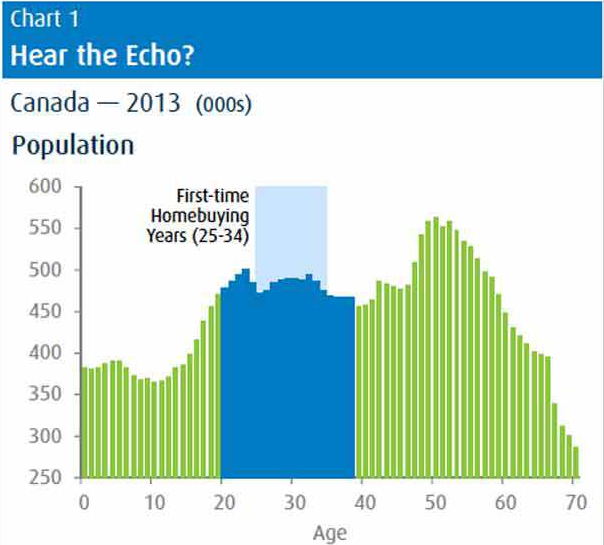
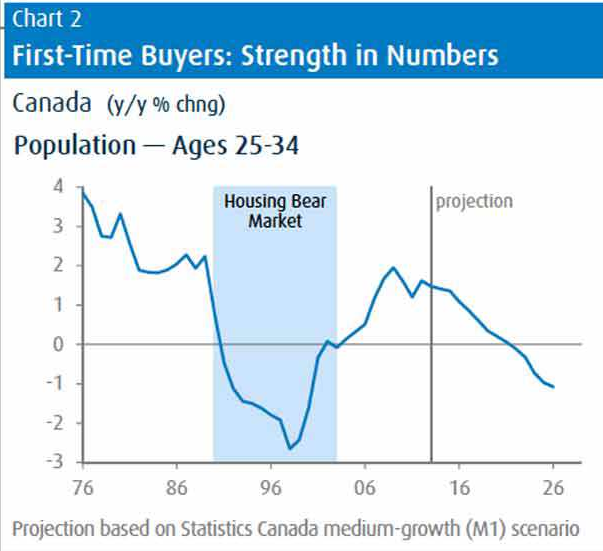 Garry Marr | June 12, 2014 8:56 AM ET | Financial Post
Garry Marr | June 12, 2014 8:56 AM ET | Financial Post
Sales improve as consumers have more choice
Click Here for the full .pdf of the CALGARY REGIONAL HOUSING MARKET STATISTICS.
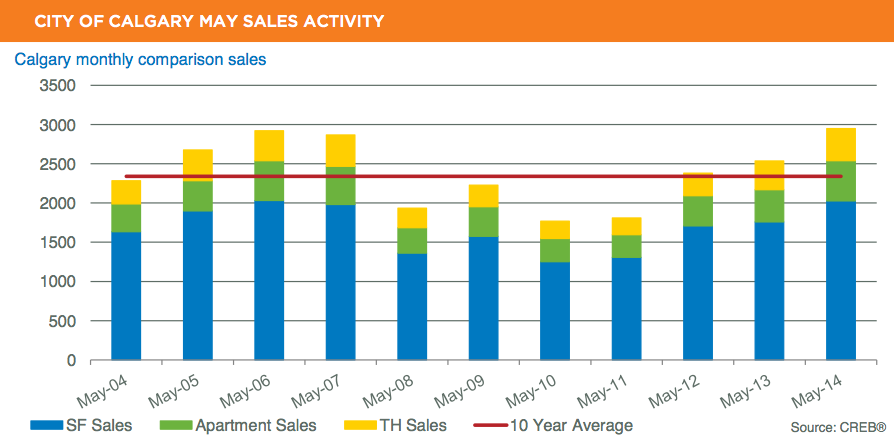
Residential sales in the city of Calgary totaled 2,948 units in May, a 16 per cent increase over the previous year.
Sales last month were well above long-term trends and are the highest May activity on record.
“Strong sales activity is a reflection of improving fundamental conditions such as a growing population, favourable lending rates and rising wages,” says CREB® chief economist Ann-Marie Lurie. “Leading up to May, resale market sales were somewhat restricted by lack of choice.
However, recent price gains have encouraged growth in new listings, helping meet some of the housing demand.”
In May, new listings totaled 4,327, a 16.5 per cent rise over figures reported during the same time last year with gains in new listings nearly matching sales growth. While inventories remain nearly five per cent below levels recorded last year, this is the first time in over two years that year-over-year declines were not in the double digits.
While market conditions continue to favour the seller, improving supply has helped ease some of the tightness in the market.
“Market conditions vary depending on the product type,” says CREB® president Bill Kirk.
“Both condominium apartment and townhouse style products have recorded inventory growth relative to last year.
This is good news for consumers looking for more choice in condominiums priced between $200,000 and $400,000.” Year-to-date condominium apartment sales have totaled 2,020 units, a 21 per cent increase over the first five months of 2013.
Meanwhile, the recent boost in new listings caused inventory levels to rise to 1,051 units, a 13.1 per cent increase compared to last year, representing 23.3 per cent of all city-wide inventories.
Click Here for the full .pdf of the CALGARY REGIONAL HOUSING MARKET STATISTICS.





